We use cookies to ensure that we give you the best experience on our website. By continuing to use this site, you agree to our use of cookies in accordance with our Privacy Policy.
 Login
Login
Your Role
Challenges You Face
results
Learn
Resources
Company
What’s Wrong with Storytelling for Fundraising


 I get it! I get it! Tell stories!
I get it! I get it! Tell stories!
There’s been a lot of talk about storytelling for fundraising recently. Just a few weeks ago lots of folks even attended a Nonprofit Storytelling Conference.
The reason I say, “I get it!” is (first) because telling stories to generate revenue is not a new concept. In fact it’s been around as long as people have been able to speak. Stories sell! Duh! But another reason is because most of the discussions I’ve seen about storytelling leave out the fact that storytelling should be a two-way street. This is wrong.
In the book “What Great Salespeople Do: The Science of Selling Through Emotional Connection and the Power of the Story” the authors studied why 13% of salespeople generate 87% of the revenue for businesses. They found that it’s because the best salespeople know how to create emotional connections with buyers (donors) by:
1. Telling stories filled with human emotion and drama
2. Helping prospects get caught up in these heartfelt stories
3. Moving past data (i.e.- 314,000 children will be hungry today) and, instead, tell stories that motivate action (i.e.- Little Susie didn’t get breakfast today and she won’t get dinner either because her mom is on drugs and her dad is in prison.).
4. Allowing more engagement and involvement by exchanging stories with prospects
The problem with too many fundraising initiatives is that they tend to tell stories without opportunities for real donor exchange and engagement. The key to closing more major gifts isn’t just telling stories. It’s exchanging them.
Don’t you love it when your donors tell you why they give? Well, they do too. So I think it’s time to open up the exchange much, much further.
By allowing an exchange of stories you help your donors build real human-to-human connections with you, your staff and those who benefit from their donations. That will motivate them to give more.
By allowing an exchange of stories you show that you care about your donor and their reasons for wanting to fulfill the needs of others.
By allowing an exchange of stories you break through barriers with your donors (barriers you might not have been able to penetrate otherwise).
By allowing an exchange of stories you get a chance to prove that you are human too – which builds trust.
By allowing an exchange of stories you give your donors a great way to come forward and engage with you and your organization on a very real, human level.
So, if you want to close more major and planned gifts, don’t just learn to tell stories to your donors. Learn to listen to your donors as they tell their stories to you too.
LIKE THIS BLOG POST? PLEASE SHARE IT AND/OR LEAVE YOUR COMMENTS BELOW
Get smarter with the SmartIdeas blog
Subscribe to our blog today and get actionable fundraising ideas delivered straight to your inbox!

Greg, I enjoyed your post. It reminded me of a great quote I came across early in my career:
“We have two ears and one mouth so that we can listen twice as much as we speak.” — Epictetus
When practicing donor-centered fundraising (and we all should be), we need to remember that it’s the prospect’s or donor’s story that matters most. That’s not to say that nonprofits should not share stories. Instead, it means, as you’ve stated, that we also need to give them a chance to share their story.
I also want to point out that while telling stories is important, we can still feel safe sharing select statistics. Carefully chosen stats, judiciously used can have a high impact. For example, when I talk to folks about child sex abuse, I almost always mention that it is a crime that affects one in four girls and one in six boys. People are usually stunned by the numbers. Then, I’m able to get into an exchange of stories. I’ve even had people disclose their own victimization to me. So, another part of creating opportunities for folks to share their stories is that you need to be prepared to respond appropriately. That’s relationship building.
Indeed Michael. Stats are best used sparingly for shock and awe. Use too many and donors’ eyes will glaze fast.
Great post Greg and the Market smart team. So many charities I see that forget to listen and ask WHY a donor gives and engages with them. Too much time and talent spent on almighty net growth while far less time connecting with current supporters who are far more important monetary value. We need to quit treating donors like ATM’s and remember they are people! Thanks again Greg and Co! Jim Weber Fundraising Fixers Melbourne Australia.